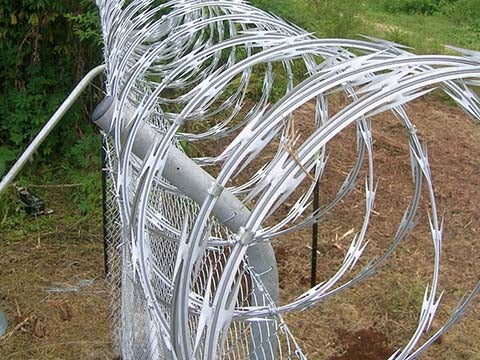Barbed wire features a long history with all the first patents being granted in 1867 in the U.S. - but it was just 7 years later that Joseph Glidden of De Kalb, Illinois invented the equipment that could produce the material in bulk that its use became widespread. It was just one or two years just before the vast open prairies of us had become pastureland sectioned off by a huge number of miles of barbed wire.
Today barbed wire remains in widespread use, although the design has recently also been refined into other fencing materials such as razor wire. However, the appearance of these 2 types of wire differs, as does their use. Let's take a closer look.
Barbed Wire
Barbed wire is manufactured out of two wires the central wire and the smaller gauge wire that may be wrapped around the centerline. It is the points in the smaller gauge wire that make up the barbs. Barbed wire remains mainly used in the same way that had been in the late 18th century - it keeps animals from wandering off property and offers a small-cost solution built to deter people from entering your property. However, barbed wire is today also to simply secure a non-agricultural property or by safety and security forces for crowd control.

Razor Wire
Razor wire was developed in the mid-twentieth century and is seen by many as superior to barbed wire. Steel tape with fine, razor edges was produced. The razor edges can seriously injure those trying to cross an area of razor wire - and furthermore, as those 'razors' are spaced closer together compared to barbs about the traditional barbed wire they may be nearly impossible to prevent.
However, there have been even further refinements created for razor wire roll. From the 1980s manufacturers took a peek back at the original barbed wire and discovered that exactly the same manufacturing process with significant improvements could give a razor wire which was far better compared to the original plus cheaper to make. this new kind of razor wire failed to use steel tape for the whole entire wire. Instead, the steel tape was shaped into stand-alone 'razors' and crimped around a steel wire core.

The outcome was really a wire that had been significantly more durable than the original design - plus it became more popular than ever. It can be today primarily employed for securing industrial and corporate sites, however, still, it finds favor with farmers who happen to be faced with particularly determined livestock.
However, it is worth noting that for many agricultural concerns the original design of barbed wire is still preferred. There are two primary factors behind this. the very first is cost - it remains the lowest-cost strategy for keeping livestock within certain boundaries. another is the fact that what may be seen as a weakness is (in particular circumstances) a strength. barbed wire will not do all the physical harm as razor wire. This helps to guard the farmer's investment. An injured animal costs money to deal with and thus it includes a superior return on investment.
Whatever your fencing needs, if security or livestock control is priorities, barbed or razor wire provides a time-proven solution.